Top 9 Facebook Ad Strategies to Maximize ROI (2026)

Over the past years, Facebook Ads (now part of Meta Ads) have undergone massive changes.
It has advanced a lot in terms of AI-driven automation, audience targeting, new creative formats, expanded ad placements, and more.
That impacts a lot on how you run your Meta campaigns.
Also, the changes and updates are meant to come and that’s for advertisers good only.
The thing is that you have to stay updated with the very latest techniques and strategies to match the changing trends and standards of Facebook Ads. Or, you might fall behind.
In this article, we’ll walk you through the 9 best Meta ad strategies that you can consider to maximize your campaign impact.
These Facebook advertising strategies may be suggestions, techniques, or best practices.
But yes, considering it will help you create a better ad campaign for Meta.
Let’s get into it.
1. Use Meta’s Advantage+ Campaigns Smartly
Meta provides a suite of AI-powered tools that help you optimize your ad campaigns.
eCommerce advertisers tend to go one way or another when it comes to Facebook ads. Either they consider relying on Advantag+ tools a lot, or they just choose to set up their campaigns manually. But I think somewhere in the middle is the better approach.
So, if you have never run an Advantage+ campaign before, we highly recommend trying it. Advantage Plus products are going to deliver better performance than the traditional method of running ads.
Be it Advantage+ Placement that effectively displays your ads across Facebook, Messenger, Instagram, and Meta Audience Network.
One of the most valuable Facebook ads strategies is to use Advantage+ tools as a supplement, not a shortcut—let AI handle scalability, but keep creative and offer control in your hands.
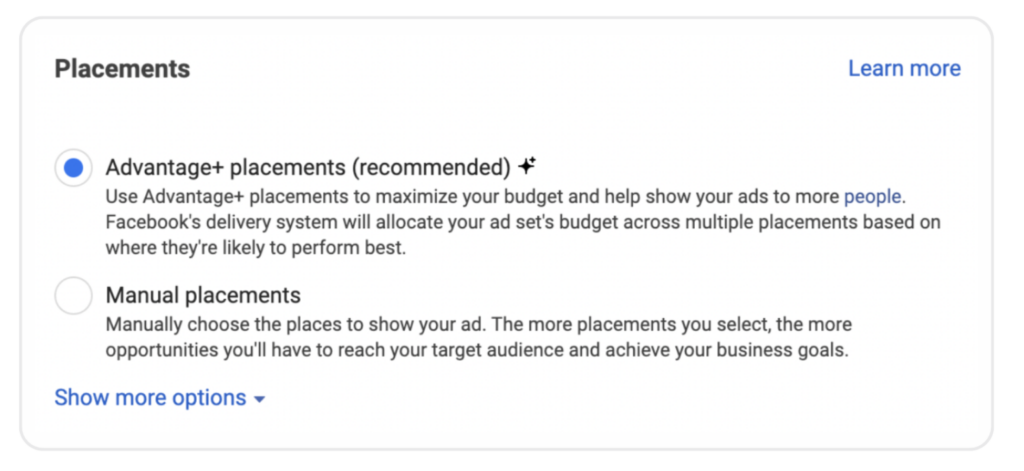
Or Advantage+ Audience which is a targeting setup that provides flexible audience suggestions rather than rigid boundaries. This allows Meta’s AI to expand beyond your defined criteria, identifying high-potential prospects who may perform as well as or even better than your original target audience.
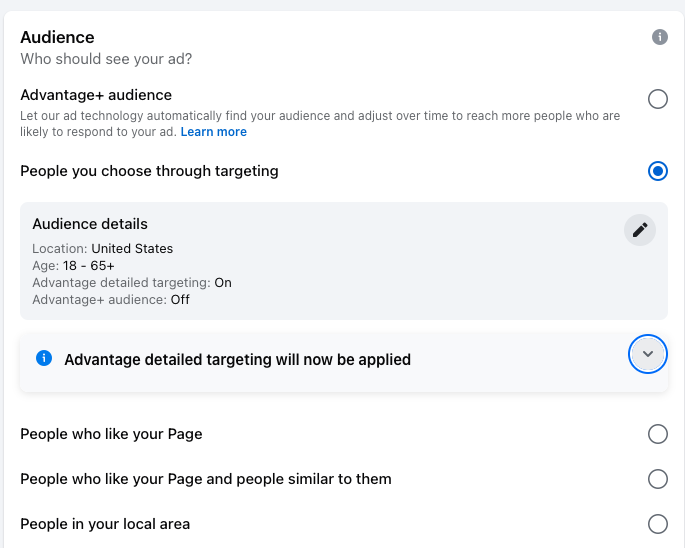
Apart from these, there are multiple other tools such as Advantage+ Creative, Advantage+ Shopping, Advantage+ Catalog Ads, Advantage Shop Ads, Advantage Website and App, Advantage Campaign Budget, and more that you can consider for your Meta ads campaign.
Initially, when Advantage+ came in, we were more skewed toward using manual sales campaigns because we like controlling and adjusting things to improve our results. However, with the evolution of AI, Advantage+ campaigns are becoming increasingly effective, and many marketers are seeing successful Facebook ad results.
I strongly recommend testing Advantage+, but don’t be surprised if it’s not your top-performing option yet.
eCommerce advertisers should re-evaluate Advantage+ Shopping every six months as it continues to improve. Over time, if it outperforms manual campaigns, you can gradually adjust your ad strategies accordingly.
Even with Advantage+, there is still room for beating the competition with your efforts. Other things like your offer, mobile ads creatives, and landing page still matter for your campaign’s success. So, there are a few tasks that are still to be managed by you.
Some eCommerce advertisers assume that I use Advantage+, so I don’t need to do anything, and that’s not true.
Remember, advantage+ tends to rely heavily on retargeting.
And with that, Meta will decide who sees your ads and how the budget is distributed between warm and cold audiences.
So, there are chances that Meta will spend your budget on an ideal customer profile who already knows you, which might not be your goal.
And it may even show a quick boost in conversion or results, but relying too much on tools is not suggested. So, it’s better not to mistake early gains for long-term consistency.
Because successful Facebook ad strategies focus on sustainable performance.
Instead, test both Advantage+ and manual campaigns to see which works best for your business because there’s always individual variance. But most of the time, Advantage +, in our experience, is going to deliver successful Facebook ad results.
Tip: Not recommended for new Facebook Ad accounts
2. Optimize Your Ads with Advantage+ Creative Enhancements
Earlier we suggested using Advantage+ tools for creating better ad campaigns. Here, we suggest one of its tools, Advantage+ Creative Enhancements even strongly.
Advantage+ Creative is Meta’s AI-powered feature that, when applied, dynamically optimizes your ad visuals to improve engagement rates. It can enhance brightness, contrast aspect ratio and generate dynamic backgrounds to better suit different placements.
For eCommerce brands looking to run Meta Ads, this means less manual work and better-performing creatives aimed at each viewer’s preferences. But only when used strategically.
Let’s check how it works.
# How Advantage+ Creative Enhancements Work?
Meta’s AI optimizes your ad creatives in three key ways:
(1) Automated Adjustments for Better Engagement:
- Tweaks images and videos (e.g., brightness, contrast, cropping) for optimal visibility.
- Adapts creatives for different placements (Stories, Feed, Reels, etc.).
(2) Dynamic Creative Variations:
- Automatically tests different versions of your ad to find the best-performing combination.
- Modifies text overlays and button placements to increase click-through rates for both desktop ads and mobile ads.
(3) Personalization Based on User Behavior:
- Meta’s AI serves different creative variations to users based on their past behavior and how they match certain buyer personas.
- Enhances relevance, increasing the likelihood of conversions.
# Best Practices for Using Advantage+ Creative Enhancements
(1) Review Enhancements Before Applying Them
✅ Upload your creative and manually check each suggested enhancement.
✅ Don’t blindly accept or reject all options; instead, evaluate them case by case.
(2) Use Enhancements Selectively
✅ Text overlays: Great for highlighting promotions, but avoid overuse if your creative already has text.
✅ Image background generation: This works well for product-focused eCommerce ads but may not suit services like personal branding or running lead ads.
✅ Video animations or music: These can make ads more engaging but unnecessary for certain industries.
For example, KFC’s attempt to engage users with AI-generated “hands-eating KFC” images on Instagram fell flat, highlighting the limits of AI in creating truly engaging brand content.
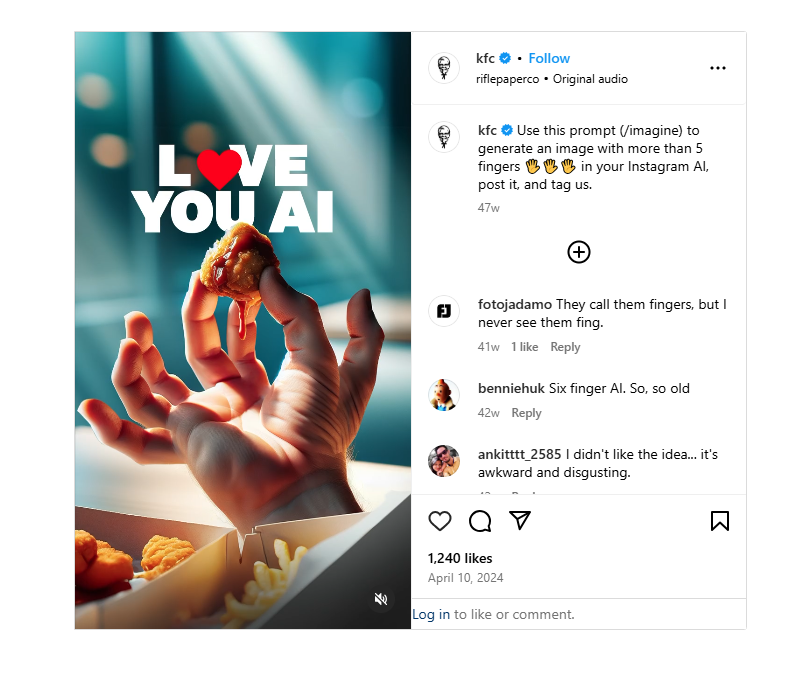
This is why audience insights still matter—creative automation should always be guided by a deep understanding of what resonates with your target audience.
(3) Align Enhancements with Your Brand Identity
✅ If your brand follows a clean, premium aesthetic, too many AI-driven changes might dilute your identity.
✅ If you run flash sales or seasonal promos, using dynamic elements like text overlays or background enhancements can be one of the strong marketing strategies for Facebook.
;
Advantage+ Creative Enhancements can enhance ad creation, improve engagement rates, and boost performance only when used thoughtfully.
One of the most underrated Facebook ads tips is to make sure you test and adjust each enhancement individually, apply what aligns with your campaign objectives, and turn off anything that doesn’t add value.
3. Partner with Influencers to Grow Your Brand
The fastest way for eCommerce businesses to build a brand is by hiring influencers. And I think in every niche, some influencers create a lot of content around products like yours and have built trust within their communities. And their advice carries a lot of weight.
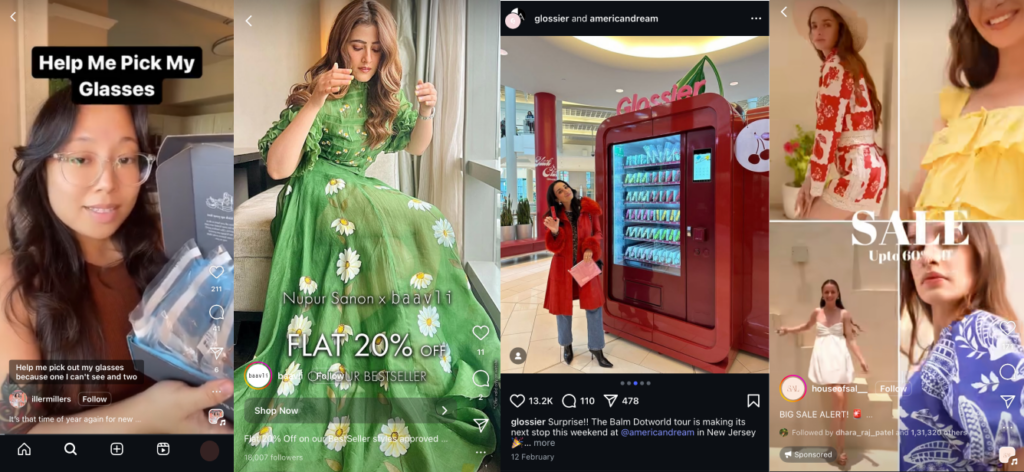
While you can hire influencers to post about your product, my favorite Facebook ad strategy is to send them the product and pay them to create high-quality video ads. Get them to:
- Demonstrate how they use your product.
- Share why they love it.
- Highlight key benefits in a natural, engaging way.
And that’s far better than traditional influencer marketing, i.e., Instagram and Facebook promotion stories, which have a short lifespan and disappear after 24 hours, whereas these video ads can be repurposed in your Facebook or Instagram ads for weeks, months, or even longer if they perform well.
Depending on your ad spend budget, you can collaborate with big influencers or micro-influencers and run tests to see what works best. This strategy not only sets you apart from the competition but also enhances brand recognition because a familiar face is demonstrating your product alongside competitors which is a smart move.
Plus, those creators save you money on ad creatives. As they’re naturally skilled on camera, they can create engaging content without the need for professional videographers.
That said, influencer marketing can be hit or miss. Some collaborations may flop, while others can significantly reduce your cost per purchase by 60–70%. The key is choosing the right influencers to maximize impact.
By partnering with the right people, you can supercharge your brand and drive real results.
When working with influencers, a key Facebook Ads tip is to ensure you get clear usage rights for the content they create, allowing you to run it as ads.
4. Reduce Campaign Complexity
Creating Facebook or Instagram ads for your store? The biggest mistake most store owners make is trying to control every little detail, which is not required in reality, as Meta’s AI can do a lot of the work for you. Instead of overcomplicating things, focus on what works:
✔ Testing & discovering what sells best
✔ Optimizing based on data
✔ Let Meta’s system refine your targeting
When it comes to Facebook advertising, simplicity often leads to better performance. That’s why keeping your structure lean and clear allows Meta to do its job more effectively.
# Do You Need Multiple Ad Sets?
The answer is to create more only when it makes sense.
Warm and cold audiences need different messaging, so it’s smart to separate them into different ad sets. But beyond that, too much audience segmentation can hurt performance because it limits Meta’s ability to optimize.
For best converting Facebook ads, keep your campaign structure simple. You can still run separate campaigns for testing and scaling, but don’t overcomplicate things with too many ad sets.
# How Many Ads Should You Run Per Ad Set?
This is where budget matters.
– Spending $1,000/day? Running up to six ads is fine.
– Spending $10–$20/day? Stick to two or three ads so each gets enough budget.
# Rule of Thumb: Six ads per ad set is the limit, not the goal.
Instead
- Run a few ads at a time, keep the winners, and swap out the underperformers.
- If you try to test too many ads at once, none of them will get enough budget to perform well.
Now, this recommendation of six creatives does NOT apply to Dynamic Ads Creative or Advantage+ Shopping campaigns.
Because these campaigns work differently, if you’re advertising a wide range of products, you’ll naturally have more combinations, and that’s fine.
Not sure which format to use?
Here’s an easy way to decide:
- Use Standard Ads if you’re testing completely different products, offers, or ad styles.
- Use Dynamic Ads Creative if you’re A/B testing small creative tweaks (different colors, angles, images, or headlines).
# Smarter Testing = Less Work for You
Before, if you wanted to test different headlines or text, you had to create separate ads for each version. Now, Meta lets you test multiple variations within a single ad:

Meta recommends using this feature because it allows the system to test different text options within a single ad rather than duplicating ads with only slight text differences.
This approach streamlines testing and improves ROI optimization, making it more efficient than running multiple near-identical ads.
It’s going to allow Meta to test better; now of course in this scenario that only works if you are going to keep your creative the same and you just want to test different wordings around your headings then this recommendation is good.
But if you want to test a completely different offer, product, or style, then I would recommend that you create different ads for them.
Similarly, if you want to test multiple creative variations—like different colors, angles, or slight design tweaks—Meta recommends using Dynamic Creative.
Dynamic Creative works well for A/B testing background colors, product images from different angles, or other minor creative adjustments, as it automatically mixes and matches elements to find the best-performing combination.
5. Focus on the Right Meta Ad Metrics to Boost Conversions
When you’re just starting with Meta Ads, it’s easy to get caught up in surface-level metrics like CTR (Click-Through Rate), CPM (Cost Per 1,000 Impressions), and CPC (Cost Per Click). But these numbers don’t always mean your ads are successful.
For example:
- A high CTR (lots of clicks) is great—but if those clicks aren’t leading to sales, the issue is likely with your landing page, offer or sales funnel, not the ad itself.
- A low CPM (cheap ads) might seem like a win, but if you’re reaching people who don’t actually buy, you’re just wasting money.
- A cheap CPC doesn’t help if those clicks aren’t turning into purchases.
Instead, focus on Cost Per Purchase (or Cost Per Lead, depending on your goal) and Return on Ad Spend (ROAS), which will actually tell you if your ads are making you money.
One of the most overlooked Facebook ad tips for beginners is to avoid obsessing over vanity metrics and instead optimize for the metrics that matter. This mindset shift is one of the first steps toward advanced Facebook marketing, where decisions are based on profitability and long-term performance—not just surface numbers.
# Why Higher CPMs [Cost Per 1,000 Impressions] Can Be a Good Thing?
Meta Ads run on a bidding system, which means the more valuable an audience is, the more expensive it is to reach them.
More competition = higher CPMs.
Let’s say you’re selling clothes online, and your ideal buyers might be frequent online shoppers who are used to spending money. Other brands are also targeting them, so ads will cost more to reach them. But these people are also more likely to buy, meaning a higher CPM can still be profitable if it leads to better sales and moves prospects effectively through your sales funnel.
This is where carousel ads can really shine—by showing multiple products or features in a single ad unit, you can increase engagement and highlight more reasons for users to click through and convert. More touchpoints in one ad = better chances to connect with different buying triggers. It’s one of the more effective Facebook ad strategies for eCommerce stores with a diverse product range.
# CTR vs. Actual Conversions—What You Should Be Looking At?
A high CTR means people are interested, but that doesn’t guarantee sales. If you’re getting clicks but no purchases, ask yourself:
- Does my landing page match my ad? (If your ad promises “50% Off” but your website doesn’t show it clearly, people will leave.)
- Is my page loading too slowly? (Most users scroll through Meta platforms on their phones, so your mobile ads experience, right from the creative to the landing page, needs to feel seamless and fast.)
- Are unexpected costs—like high shipping fees—causing people to abandon their carts?
# Using Meta’s Chart Data to Improve Your Ads
Instead of constantly changing your target audience, use Meta’s chart data to tweak your ad messaging.
- If certain age groups or genders are converting better, adjust your ad copy and images to speak directly to them.
- If sales drop at certain times of day, try adjusting your ad schedule to focus on peak times.
- If certain slides in your carousel ads are getting more engagement than others, use that insight to guide future creatives—highlight what’s resonating most.
By focusing on the right data points, you’ll make smart, small changes that lead to better results over time—without overcomplicating things or breaking your sales funnel.
6. Take Advantage of Opportunity Score Provided By Meta
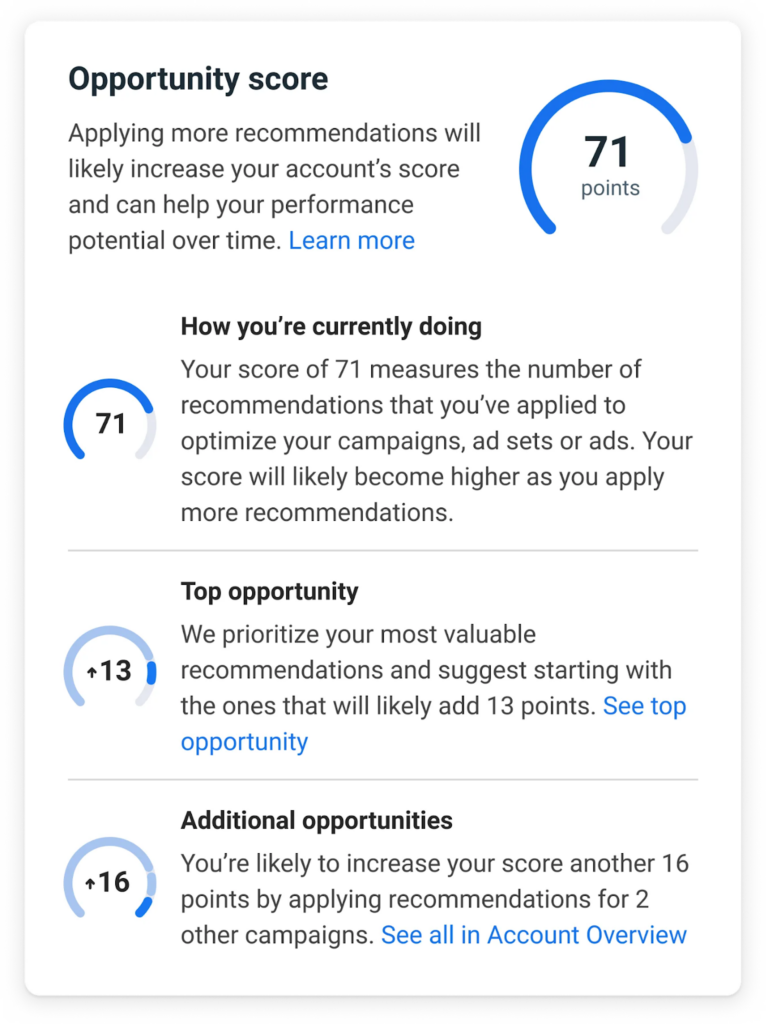
Opportunity Score is a relatively new feature, and not all ad accounts have access to it yet. But for your information, let me give you a quick overview. This score is a gamified recommendation from Meta to improve the performance of our Facebook ad campaigns and ad sets.
They are giving very valuable and specific recommendations on how to get higher scores, which they say will, in turn, lead to better results.
Meta doesn’t want Facebook ad strategists to think that a high score necessarily equals great results.
You could have a campaign that is optimized perfectly, exactly optimized as per Meta’s recommendations, but the product or service you sell is not liked by your potential customers from a result, ROAS or conversion funnel standpoint.
So it doesn’t equal good results.
How does it work?
So the recommendations that we see in the opportunity score (tool) depend on how your campaign and ad account are set up. You will see different recommendations around:
- Budget
- Campaign structure
- Ad sets
- Creating more ads
- Pixel data quality (tracked via the Meta Pixel)

We have also got an interesting feature called ‘automatic adjustment’ through which Meta will automatically implement all these recommendations wherever possible on your behalf.
Now that’s something we would recommend doing because all the recommendations are not the ones that you need to take up.
Most of the recommendations that Opportunity Score offers are good, since this is based on AI. However, you should not approve all that it suggests.
Instead, understand it well and accept the ones that truly bring value to your campaign.
7. Scale Your Meta Ads Smartly Without Resetting Performance
Meta now allows Facebook ad strategists to scale in larger increments without re-entering the learning phase. Something that was previously tricky due to how sensitive Meta’s learning phase used to be to budget shifts and bidding strategies.
It was sort of accepted wisdom for a long time that you couldn’t increase the budget by more than 10% or 20% without wrecking ad performance. Like, you’d scale up and suddenly your successful Facebook ads results would crash overnight. But that’s not the case anymore.
As opposed to it now, you can significantly scale in larger increments, sometimes as much as doubling. Sometimes, I have seen even more without even entering the learning phase.
The extent to which you can scale depends on your current budget.
So you can scale in larger percentage increments.
- If you’re working with a small budget (e.g., $10 per day), you can easily increase it to $20 per day.
- Even at a larger scale, you can go from $10,000 to $20,000 per day in one jump, though that might be a bit too aggressive.
This is especially important for eCommerce advertisers, particularly those running time-sensitive promotions. I’ve had multiple conversations recently with advertisers who wanted to scale quickly for events like Black Friday, Christmas sales, or other time-sensitive offers.
So if you have a Black Friday offer, a Christmas sale, or any other offer that works for your business, it’s like we have only three days left. And you are wondering, can I increase the budget by 10 or 20%?
We suggest you should go for it. If things are working well, whack that budget up.
Now, of course, your budget, your cost per purchase, as well as your cost of lead may go higher. But I think the potential reward is worth the risk.
If it works, you can acquire a lot more customers and make the most of that short window of opportunity by moving them into sales funnel.
However, we would still recommend that you be cautious when it comes to scaling.
You don’t want to mess up your campaign if it’s an evergreen one that you plan to run for weeks, months, or even years.
But just know that you can be more aggressive and scale bigger when the time is right.
8. Write Video Hooks That Instantly Grab Attention
Many Meta advertisers are quite unsure of video ads, and I completely understand as they are much more difficult to create than image ads. There’s a much greater chance that you create a video ad and it just looks okayish in comparison to an image ad.
But the potential rewards of producing a high-quality video ad are well worth the effort and can make up for those difficulties and that added complexity in terms of creating them in the first place. So, just like I talked about earlier, there are parts of Meta-advertising that you want to focus on and spend your time and effort on. Among the most effective Facebook ad tips is to invest in better creative assets, especially video hooks.
Because those are the things that move the needle and make the difference.
The equivalent of that for a video ad is the hook.
The hook is the first three seconds of a Facebook video ad, and that’s the part that is either going to grab people’s attention or not.
And by improving the hook and keeping the rest of the video the same, you can double or more than double your eternal ad spend. So, if you’re running video ads and want better results, start by writing attention-grabbing hooks.
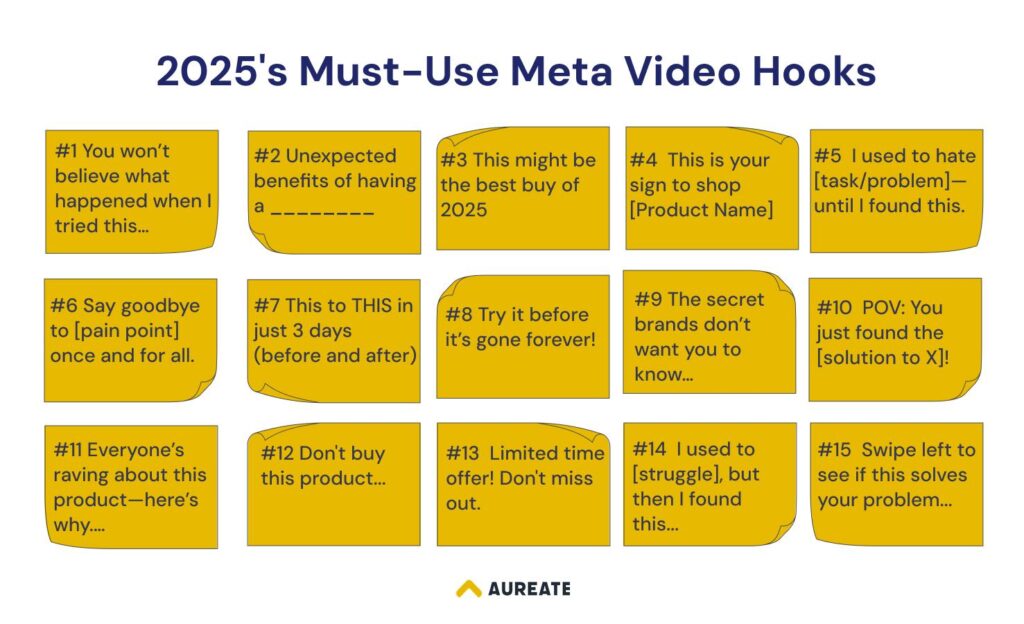
Another thing, adding good hooks to your video ads isn’t where your job ends. Your chosen hook should create a flow for the content coming after it. That’s the best Facebook strategy to creating an impactful video ad.
9. Maximize Sales by Re-Engaging Your Existing Customers
Instead of focusing solely on new customer acquisition, put more effort into customer reactivation.
Now, I’m not saying you should spend more on reactivation than on acquiring new customers. Typically, you wouldn’t invest more in retargeting than in cold audience campaigns unless you have a large customer base or warm audience.
However, most eCommerce businesses significantly undervalue customer reactivation. Many assume that once someone buys from them, they’ll naturally return.
But the reality is that your past customers aren’t constantly thinking about your business. They’re busy with their own lives, they are distracted, and if you don’t remind them, they’ll forget.
#How to Bring Past Customers Back?
✅ Retargeting campaigns on Meta Ads – Keep your brand in front of previous buyers by using custom audiences built from your customer list, website visitors, or app users.
✅ Email marketing – Send reminders, offers, or personalized product recommendations.
✅ Exclusive deals or free samples – Give customers a reason to return.
A lot of advertisers also believe that it’s a waste of money to put ads in front of people who have already bought and that’s not true. But again, your customer base is likely a small fraction of your overall audience, meaning it won’t cost much to keep your brand in front of them.
Let’s suppose you have 5000 customers; the cost to regularly re-engage them with ads is minimal. Given the potential for repeat sales, it’s well worth the investment.
Thus, customer remarketing or retargeting is the best Facebook ad strategy to boost your sales without the need to constantly chase new customers.
For targeting cold audiences, one of the best Facebook ad tips is to use lookalike audiences meaning targeting people who are similar to your existing customers.
You can also combine this with interest targeting to refine your reach and connect with people likely to be interested in your niche.
The Final Steps: Maximizing Your Facebook Ad Impact
Best practices are guidelines, not guarantees. They don’t guarantee success, but they do increase the odds when executed thoughtfully.
That said, before making a high-stakes investment in a costly Facebook ad campaign, start small. Run experiments, A/B test your ideas, and identify what resonates before scaling up.
Use the Facebook marketing techniques we’ve discussed as a foundation, but don’t stop there. Success isn’t just about the mechanics—it’s about injecting emotion, urgency, and creativity into your approach. The thrill of innovation comes from A/B testing new ideas before anyone else.
You now have 9 strategies to craft a winning Meta ad strategy.
Put them to the test. Set them up, execute, refine, and see what takes shape over time.
When you spot a winning pattern in your data, double down on it. And if you’re looking for expert insights, fresh ideas, or a second pair of eyes on your Facebook ad campaign strategy, our Aureate Lab team is just a call away.
Tell us what’s working, what’s not, and how we can help refine your approach for even greater success.






Post a Comment
Got a question? Have a feedback? Please feel free to leave your ideas, opinions, and questions in the comments section of our post! ❤️